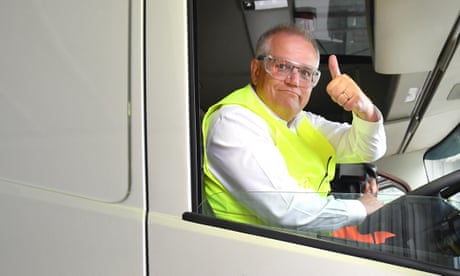Extract from The Guardian
Even the industry’s own data suggests its impact on emissions is extraordinarily marginal
- Temperature Check is a weekly column examining claims about climate change made by governments, politicians, business and in the media. See the latest column and follow the series here

Last modified on Thu 11 Nov 2021 03.32 AEDT
The Morrison government wants to put more taxpayer money into carbon capture and storage (CCS) projects, with a new $500m fund that could include the technology alongside other new projects.
The emissions reduction minister, Angus Taylor, told the ABC on Wednesday “there’s 60 [CCS] projects around the world, 30 in operation. It’s working in large quantities now.”
There’s certainly growth in carbon capture and storage around the world, but do they work?
According to the industry’s Global Carbon Capture and Storage Institute, there are 29 CCS facilities up and running around the world (two of those have been suspended).
But there’s a massive catch if you’re hoping these are good for the climate.
Twenty-two of those 29 projects are primarily injecting CO2 into geological formations in order to push out more oil and gas, in a process known as enhanced oil recovery (EOR).
There’s a massive catch if you’re hoping these CCS facilities are good for the climate.
Only about 11m tonnes of CO2 a year is being captured at projects that are not EOR, according to the institute’s data.
The institute says as of September this year CCS projects are growing and have the capacity to capture 111m tonnes of CO2 a year.
The institute lists four more projects “under construction” (three of which are EOR) and 58 in “advanced deployment” stage.
When Taylor says CCS is “working in large quantities now”, what the industry’s own data suggests is that its impact on emissions is extraordinarily marginal, even without knowing the impact of burning the extra oil and gas that many of the projects are designed to extract.
According to the Australia Institute, a thinktank critical of CCS, Australian taxpayers have put $4bn into the technology over the years.
Perhaps not burning the fossil fuels in the first place may be a more efficient way to bring emissions down? Just an idea.
Electrical electioneering
Scott Morrison’s claims in 2019 that more electric cars on the road would “end the weekend” have returned like an electrified ghost to haunt him.

During the launch of the government’s plan for electric vehicles this week, the prime minister was asked if he could “honestly say” he was “not attacking electric vehicles” back then.
Morrison snapped back, saying there had been a “massive change” in technology over the past few years. An incredulous reporter pushed again, asking if that had really occurred in the last two years?
“Yes, yes, a massive change,” replied Morrison, trying to suggest one reason for his backflip was that the circumstances had changed.
When Morrison said in 2019 that an electric vehicle “won’t tow your trailer” and was “not going to tow your boat” he clearly hadn’t watched the Qantas corporate video from 2018 of a Tesla towing a passenger jet. They’re just a bit heavier than boats and trailers.
If Morrison was referring to sudden advancements in charging infrastructure in recent years, then this is also wrong.
According to the Electric Vehicle Council, in 2018 there were already 783 charging locations in Australia, and Queensland already had 24 direct current fast chargers. Ultra-fast chargers that can add hundreds of kilometres of range to an electric car in 15 minutes were being installed in 2018.
Is Morrison referring to “massive” changes in hydrogen vehicle technology?
The first hydrogen refuelling station was commissioned in Australia in 2019 and the country registered its first hydrogen fuel cell car – the Hyundai Nexo – in 2019. Toyota’s fuel-cell electric car, the Mirai, was officially launched in 2014.
As a side note, Morrison said the government did not want to “drive these costs [of new technologies] down by writing off big cheques to multinational companies” while standing at Toyota’s hydrogen centre that received $3m of taxpayer cash in 2019.
Not much Cop
The Cop26 climate talks in Glasgow are scheduled to conclude on Friday, with negotiators working through a raft of issues to come up with a final text.
“Glasgow of course achieved little when it came to climate policy, in fact it might have helped to expose the hypocrisy and futility of the UN climate action process,” said Kenny, with a week of talks left to go.
Kenny invited climate science denialist and mining industry figure Ian Plimer, a geologist, on to his show to promote his new book Green Murder, which carries the catchy subtitle “A life sentence of net zero with no parole”.
Plimer was also happy to make an assessment of Cop26 a week before it ended, saying “the only great recommendation to come out of Glasgow was to reduce methane emissions by 30 per cent”.
Plimer was referring to a push from the European Union and the United States for countries to reduce emissions of methane – a potent greenhouse gas – by 30% by 2030. Australia has refused to sign.
But then Plimer – who denies there’s any evidence that human emissions of carbon dioxide have caused global heating – made another claim.
“Most of the world’s methane comes from rice paddies and these are in the Indian subcontinent, Asia and Brazil,” he said.
Plimer’s argument was that reducing methane would force a reduction in rice production, which would “starve people.”
Except Plimer’s claim “most of the world’s methane comes from rice paddies” is contradicted by studies into human-caused methane emissions.
The most recent examination of human-caused emissions of methane shows rice cultivation accounts for just under 8% (or 30m tonnes).
This is tiny compared with the oil and gas industry which is responsible for 22% (84Mt), coalmining at 11% (44Mt) or livestock (mostly burping cows) at 30% (115Mt).
No comments:
Post a Comment